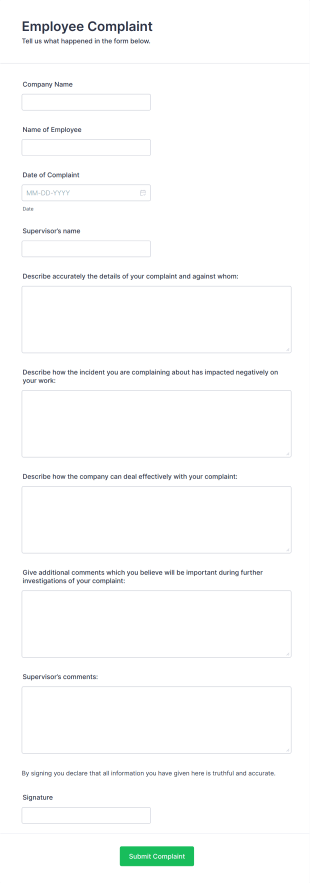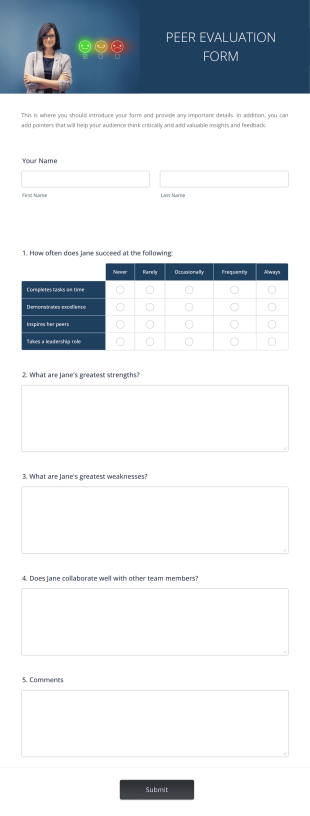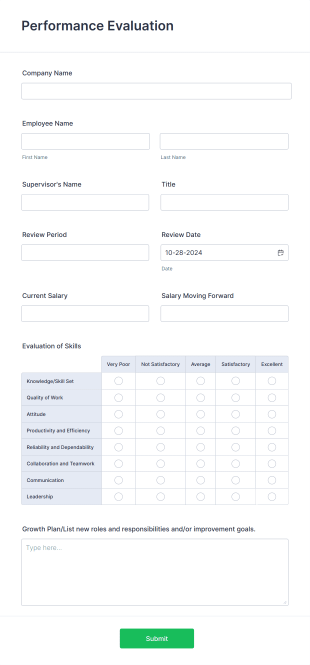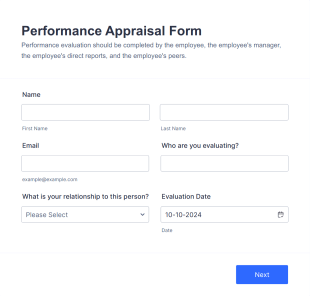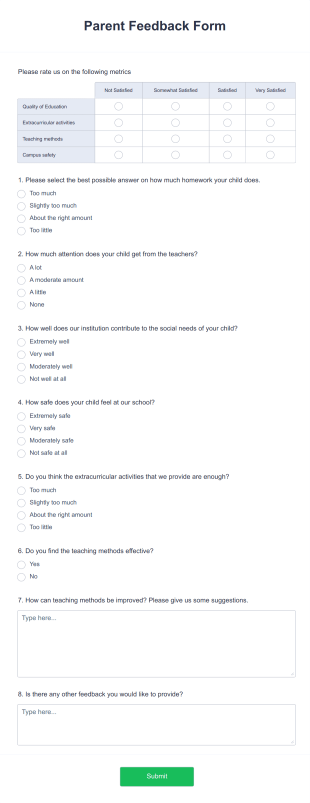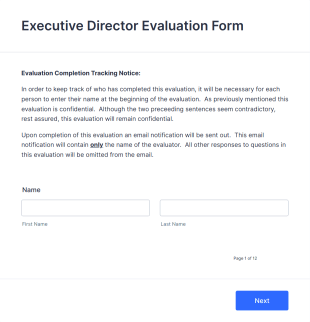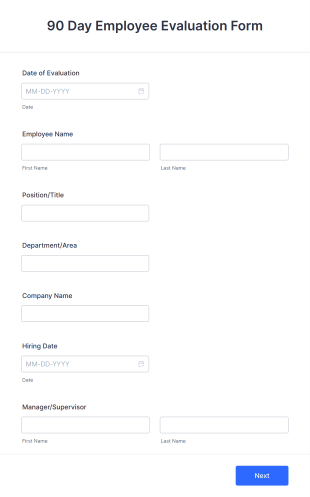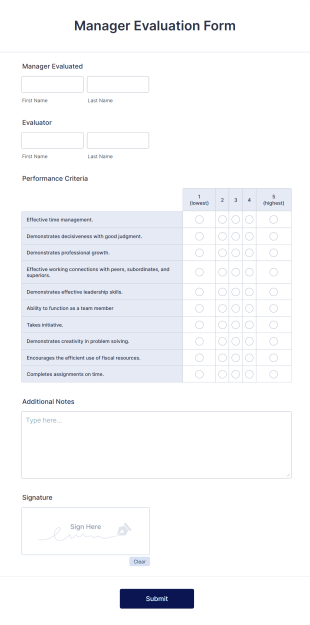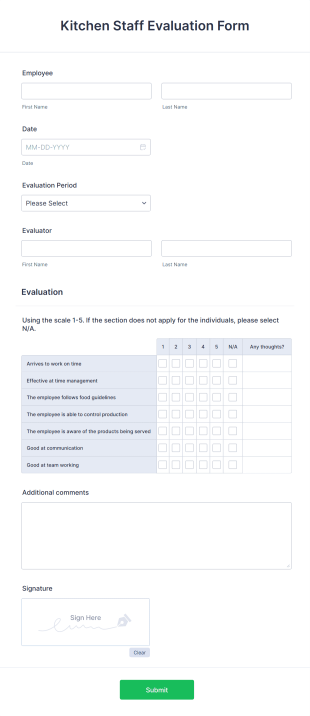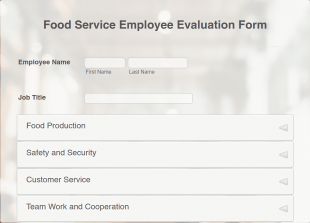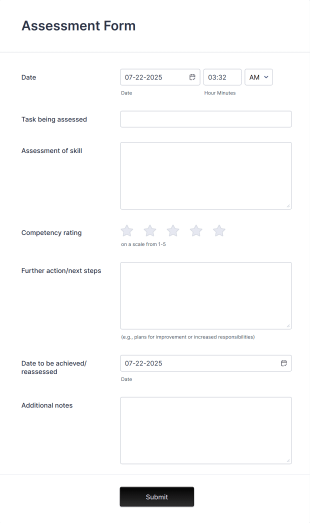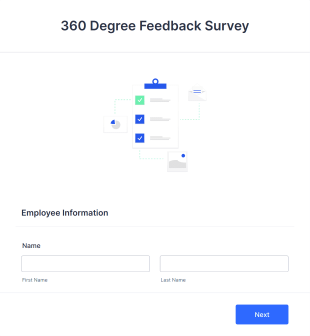Employee Evaluation Forms
Employee Performance Evaluation Form
An Employee Performance Evaluation Form is a form template designed to track individual performance, monitor employee progress, and provide detailed feedback to employees.
Go to Category:Human Resources FormsRemote Work Survey
Analyze your current work from home policy with a free online Remote Work Survey. Ideal for coronavirus-related remote workplaces. Sync responses to 100+ apps.
Go to Category:Human Resources FormsSelf Evaluation Template
Create the perfect Self Evaluation Form for your employees. Collect, view, and manage responses on any device. Free to use and easy to customize!
Go to Category:Human Resources FormsEmployee Complaint Form
An employee complaint form is used to document a complaint from an employee against another employee, senior manager, or supervisor.
Go to Category:Human Resources FormsSupervisor Evaluation Form
A Supervisor Evaluation Form is a versatile tool designed to streamline the process of conducting performance evaluations for employees
Go to Category:Human Resources FormsPeer Evaluation
A Peer Evaluation form is a form template designed to streamline the process of collecting feedback and evaluations from peers in the workplace
Go to Category:Peer Evaluation FormsPerformance Evaluation Form
A performance evaluation form is used by employers to evaluate the performance of the employees and track their progress.
Go to Category:Human Resources FormsRestaurant Employee Evaluation Form
Manage your restaurant staff with a free, online evaluation form you can send to supervisors. Easy to customize, download, print, and share. No coding required.
Go to Category:Restaurant Evaluation FormsPerformance Appraisal Form
A performance appraisal form is used to evaluate employees’ work performance in order to see what they’re doing well and what they need to improve on.
Go to Category:Employee Evaluation FormsEmployee Engagement Survey
Employee Engagement Survey meets your needs! By using this Employee Engagement Survey, you can learn how satisfied your employees are at your company in order to improve your working conditions.
Go to Category:Human Resources FormsParent Feedback Form
Now, the feedback of the parents, as well as the students, is important. Collect feedback and improve your organization with the Parent Feedback Form. No code required!
Go to Category:Education FormsConstruction Employee Evaluation Form
Monitor construction workers with this free, online evaluation form. Easy to customize and complete on any device. Download, print, and share reviews. No coding.
Go to Category:Human Resources FormsExecutive Director Evaluation Form
An Executive Director Evaluation form is a questionnaire used by non-profit organizations to gather feedback from employees. No coding!
Go to Category:Human Resources FormsEmployee Self Appraisal Form
An employee appraisal form is a type of self-assessment form used by managers, supervisors, and team leaders to keep track of and evaluate employee performance.
Go to Category:Business Forms90 Day Employee Evaluation Form
Monitor the improvement of a new employee by using this 90 Day Employee Evaluation Form. This form is helpful in deliberating if the employee is suitable for the position or not.
Go to Category:Human Resources FormsManager Evaluation Form
A manager evaluation form is a questionnaire that helps supervisors to rate the performance of their employees. Use this Manager Evaluation Form to ask your employees for feedback about their work.
Go to Category:Human Resources FormsKitchen Staff Evaluation Form
Keep your restaurant in business. Evaluate chefs with our free, customizable evaluation form. Receive feedback from supervisors. View and edit on any device.
Go to Category:Human Resources FormsProbationary Evaluation Form
A probationary evaluation form is a survey that is used by employers to understand how new employees are adjusting to a new job and workplace environment. No coding!
Go to Category:Employee Evaluation Forms360 Degree Review Form
A 360-degree review form is a professional peer-review survey that allows employees to evaluate the skills and knowledge of a coworker or subordinate. Whether you’re a manager or an employee, use this 360 Degree Review Form template to conduct an anonymous, online peer review!
Go to Category:Employee Evaluation FormsFood Service Employee Evaluation Form
Get feedback about employees online and improve your restaurant. Customize and share with supervisors in minutes. Easy to fill out on any device. No coding.
Go to Category:Human Resources FormsAssessment Form
An assessment form is a questionnaire used to make assessments with all necessary metrics included. Go online with no coding!
Go to Category:Business FormsAnnual Peer Performance Evaluation Form
An annual peer performance evaluation form is used by a supervisor to provide feedback to their employees on their performance over a year. Boost your progress via Jotform. No coding.
Go to Category:Human Resources FormsEmployee Payroll Change Form
An employee payroll change form is a document, often used by human resources personnel, which details a change made to an employee's pay rate. No coding!
Go to Category:Business Forms360 Degree Employee Evaluation Survey
A 360 degree employee evaluation survey is a survey that employees or employers can use to get a picture of what their organization looks like from multiple perspectives.
Go to Category:Survey Templates


